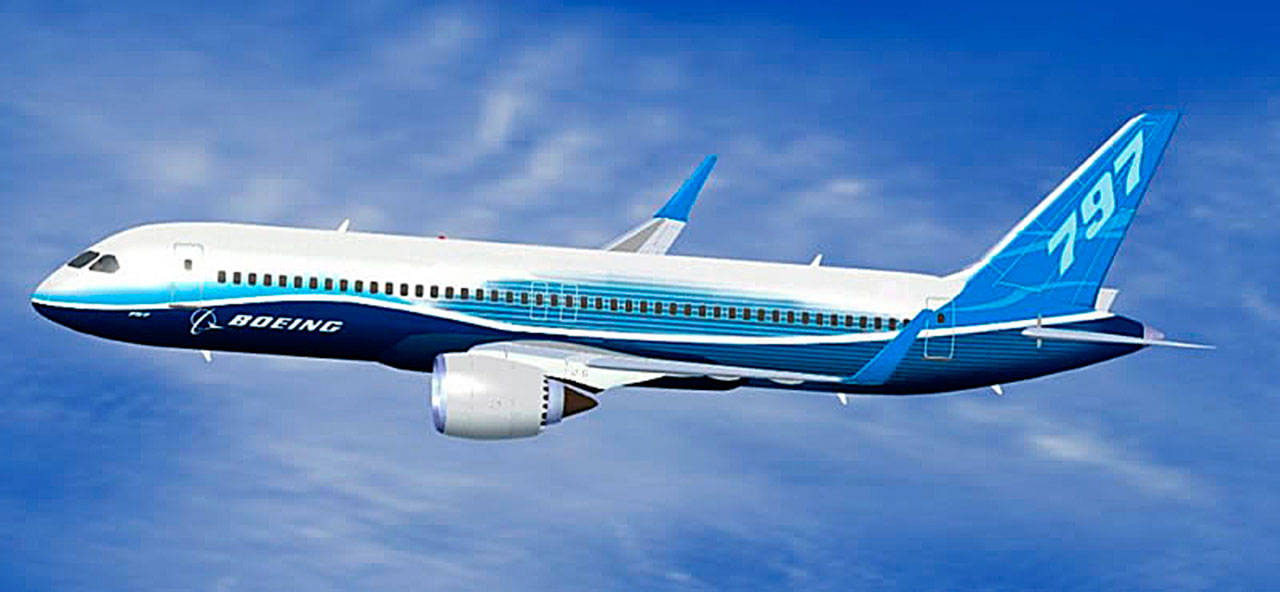By Julie Johnsson, Bloomberg
United Continental Holdings has taken a close look at an all-new jetliner that Boeing engineers are developing for trans-Atlantic flying, and the airline likes what it sees.
“What we’ve seen so far is very, very interesting to us,” said Andrew Levy, United’s chief financial officer. “We certainly hope Boeing launches the airplane. We think there is a need for it.”
An endorsement from United, a large Boeing customer, would go a long way toward making the business case for so-called middle-of-market jetliners. While the airplane concept exists only on paper so far, Boeing has honed the design to seat between 225 and 260 passengers and worked to bring production costs in line with prices that airlines would be willing to pay.
“I wouldn’t be surprised if there is a decision to offer by this year,” John Plueger, chief executive officer and co-founder of Air Lease Corp., said of the first step in Boeing’s process to formally introduce a new plane. “That might be a bit early, a bit aggressive. But that would not surprise me.”
United had been among the skeptics of the jets that Boeing has spent years developing to fill the gap in its product line-up between the largest of the narrow-body 737 models and the smallest 787 Dreamliners. As Boeing is designing a twin-aisle aircraft with the range to fly from London to New York, budget carriers are shifting more mid-range flying to relatively inexpensive narrow-body jets such as Airbus Group’s A321neo.
After delving deeper into the Boeing design, “we’re convinced, we get it. We understand the economics,” Levy said Tuesday at the ISTAT annual conference in San Diego. “We thought a twin made no sense, but we walked through it and had our questions answered. From what we’ve seen, we like it. But it’s a paper airplane. Hopefully they’ll launch it.”
Timing and price are two of the critical elements that Boeing must consider in its high-stakes chess match with Airbus for market dominance. Billions of dollars of investment are at stake, and the payoff can be thwarted by factors ranging from cheap oil to supplier stumbles. Boeing has been planning its new family of mid-range aircraft, while Airbus has been marketing upgrades of existing jetliners: the A321, its largest narrow-body, and A330 wide-body jets.
Boeing’s jet, which would probably be known as the 797, may begin flying in 2025, said Steven Udvar-Hazy, who co-founded Air Lease and is influential in shaping product strategy for Boeing and Airbus. The engine technology and break-through design of the new aircraft will be critical since it may fly through 2060, he said.
Shareholders of Boeing may balk at total development costs expected to range from $10 billion to $15 billion, Ron Epstein, an analyst with Bank of America Merrill Lynch, said in a note to clients Wednesday. But if the U.S. planemaker spends too much time refining its design and manufacturing plans, it risks losing the market to Airbus, he said.
“If Boeing waits too long, Airbus may be an early mover and introduce an A322neo that could address this market,” Epstein said, referring to a rumored new Airbus aircraft.
Udvar-Hazy isn’t convinced that Boeing has figured out the magic blend of price, performance and production costs that will make the 797 a best-seller.
“Boeing has to really wrestle with that issue,” he said Tuesday. “As we sit here today, the cost of developing and manufacturing the airplane at a price that gives the airlines value — I don’t think that equation has been solved.”
That’s the most difficult task Boeing has, especially after what happened with the 787, when they “grossly under-estimated the R&D,” Udvar-Hazy said in reference to the Boeing carbon-composite jet, whose costs are thought to have ballooned past $50 billion. “I don’t think Boeing wants to make a mistake, so they are really pinning down what it takes to make that airplane.”
The key for Boeing is “not to overbuild the airplane,” said Aengus Kelly, CEO and executive director of AerCap Holdings, referring to technology and engine performance that can drive up cost. “If you overbuild it, you start encroaching on the 787 market. If you underbuild it, you run into the A321 market,” which Boeing’s all-new plane couldn’t match on price.
Boeing envisions two models to fill the overlapping market segments served by its out-of-production 757 narrow-body and 767 wide-body jets, which were developed jointly in the late 1970s and early 1980s and share the same cockpit design.
“One will be bigger and fly not quite as far, one will be smaller and fly farther,” said Randy Tinseth, a Boeing marketing vice president. “To some extent you address the single-aisle market, to some extent you address the wide-body market and to some extent you are stimulating growth where no one has been before. And that has been a fascinating part of the whole project.”
Airbus could counter by improving the wing design of the single-aisle A321neo to yield another 2 percent to 3 percent in fuel savings, or undercutting Boeing on price with a cheaper, lighter version of the A330neo, Udvar-Hazy said. The European planemaker wouldn’t need to consider an all-new aircraft unless the Boeing plane proves to be a sales smash, he said.
United eventually will need to replace the 128 Boeing 757 and 767 jetliners in its fleet, and has studied Airbus’s A321neo as a possible substitute for the aging narrow-body, particularly on flights from the eastern U.S. to Europe, Levy said.
“The 767 replacement that is available now is bigger than we’d like,” he said. “The 757 replacement that is available now is the A321, which is a great airplane. It can do 90 percent, maybe 95 percent of what we’d like it to do. But the other 5 to 10 percent is really critical.”
Talk to us
> Give us your news tips.
> Send us a letter to the editor.
> More Herald contact information.

























